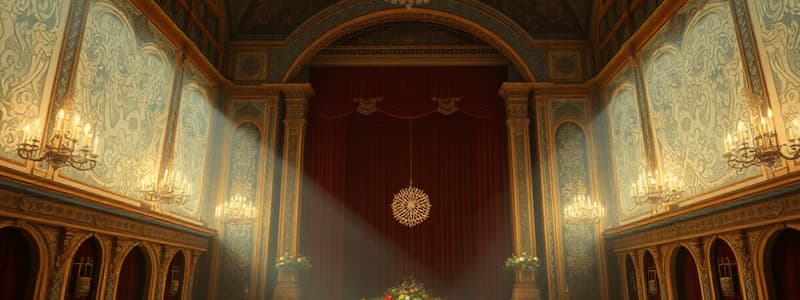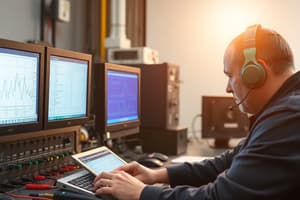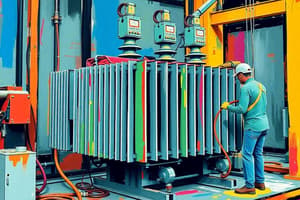Podcast
Questions and Answers
Match the following stages of the lighting process with their descriptions:
Match the following stages of the lighting process with their descriptions:
Technical Testing (Dry Tech) = Session where initial cue issues are identified and fixed Q-2-Q Sessions = Review of cue timings and adjustments made based on script changes Dress Rehearsals = Final rehearsals which may still require cue modifications Final Printout = Last version of cue sheet retained for reference during the production
Match the components of the lighting console with their functions:
Match the components of the lighting console with their functions:
Backup Button = Allows digital backup of all cues Cue Sheet = Document with timing and level information of cues External Hard Drive = Storage for digitally backed up cue information Printer = Used for producing hard copies of cue sheets
Match the roles involved in the lighting process to their responsibilities:
Match the roles involved in the lighting process to their responsibilities:
Lighting Designer = Responsible for changes in cue timing and design Stage Manager = Maintains organization of cues during rehearsals Director = Approves final version of cues and changes Lighting Console Operator = Enters and manages cues during rehearsals
Match the types of changes that can be made to cues with their situations:
Match the types of changes that can be made to cues with their situations:
Match the types of records with their purpose:
Match the types of records with their purpose:
Match the rehearsal types with their characteristics:
Match the rehearsal types with their characteristics:
Match the reasons for cue adjustments with their contexts:
Match the reasons for cue adjustments with their contexts:
Match the documentation aspects of lighting design with situations they address:
Match the documentation aspects of lighting design with situations they address:
Match the stages of preparation with their focus areas:
Match the stages of preparation with their focus areas:
Flashcards are hidden until you start studying
Study Notes
Testing Process and Cue Modifications
- Changes to cues can arise from technical issues like patching problems or incorrect information entry.
- Cues undergo testing and modifications until they are approved during a 'dry tech' session.
- Even if technical aspects are correct, further cue modifications may occur during 'Q-2-Q' sessions, focusing on timing and script changes.
Dress Rehearsals and Cue Management
- Modifications to cues may continue during dress rehearsals.
- Cue sheets are marked up, and lighting console operators re-enter new cues as needed.
- Many lighting systems include printers for real-time cue recording, ensuring a 'hardcopy' is maintained after changes.
Backup and Safety Protocols
- During lighting rehearsals, designers may request printouts of all cues for backup after specific rehearsals.
- In case of a control system crash, it may be necessary to manually re-enter cue and level information into a new system.
- Computer-assisted consoles typically feature an external hard drive for digital backup of cues.
Final Printouts and Production Readiness
- A final printout of cues is usually generated just before the opening production, once changes are finalized.
- The stage manager, director, and designer typically keep a copy of the final printout throughout the production.
- If a production relocates to a new venue, the cue sheet printout serves as a guide for reconstructing the lighting setup.
Studying That Suits You
Use AI to generate personalized quizzes and flashcards to suit your learning preferences.




